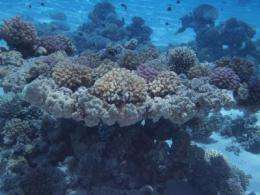At least one-third of marine species remain undescribed, study says

At least one-third of the species that inhabit the world's oceans may remain completely unknown to science. That's despite the fact that more species have been described in the last decade than in any previous one, according to a report published online on November 15 in the Cell Press publication Current Biology that details the first comprehensive register of marine species of the world—a massive collaborative undertaking by hundreds of experts around the globe.
The researchers estimate that the ocean may be home to as many as one million species in all—likely not more. About 226,000 of those species have so far been described. There are another 65,000 species awaiting description in specimen collections.
"For the first time, we can provide a very detailed overview of species richness, partitioned among all major marine groups. It is the state of the art of what we know—and perhaps do not know—about life in the ocean," says Ward Appeltans of the Intergovernmental Oceanographic Commission (IOC) of UNESCO.
The findings provide a reference point for conservation efforts and estimates of extinction rates, the researchers say. They expect that the vast majority of unknown species—composed disproportionately of smaller crustaceans, molluscs, worms, and sponges—will be found this century.
Earlier estimates of ocean diversity had relied on expert polls based on extrapolations from past rates of species descriptions and other measures. Those estimates varied widely, suffering because there was no global catalog of marine species.
Appeltans and colleagues including Mark Costello from the University of Auckland have now built such an inventory. The World Register of Marine Species (WoRMS) is an open-access, online database (see www.marinespecies.org/) created by 270 experts representing 146 institutions and 32 countries. It is now 95% complete and is continually being updated as new species are discovered.
"Building this was not as simple as it should be, because there has not been any formal way to register species," Costello says.
A particular problem is the occurrence of multiple descriptions and names for the same species—so called "synonyms," Costello says. For instance, each whale or dolphin has on average 14 different scientific names.
As those synonyms are discovered through careful examination of records and specimens, the researchers expect perhaps 40,000 "species" to be struck from the list. But such losses will probably be made up as DNA evidence reveals overlooked "cryptic" species.
While fewer species live in the ocean than on land, marine life represents much older evolutionary lineages that are fundamental to our understanding of life on Earth, Appeltans says. And, in some sense, WoRMS is only the start.
"This database provides an example of how other biologists could similarly collaborate to collectively produce an inventory of all life on Earth," Appeltans says.
More information: Appeltans et al.: "The Magnitude of Global Marine Species Diversity", DOI: 10.1016/j.cub.2012.09.036
Journal information: Current Biology
Provided by Cell Press


















